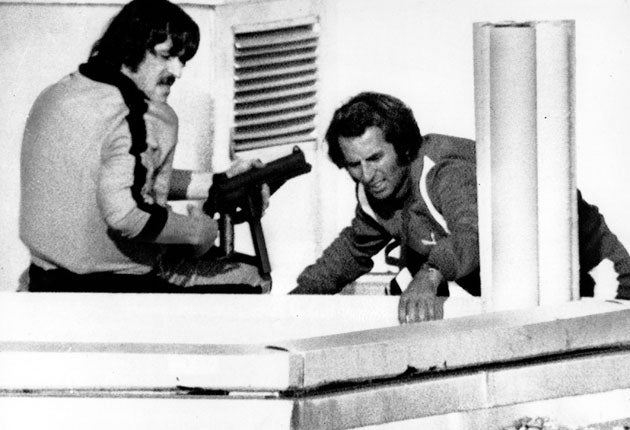Shoot to kill, Britain's answer to massacre at Munich
Secret document reveals MoD advice after 1972 slaughter of Israeli athletes

In the wake of the 1972 Munich Olympics massacre, military commanders gave soldiers carte blanche to shoot hostages should nuclear weapons be the target of terrorists. The murder of Israeli athletes at the Games sent a wave of panic through Western governments at the bloody arrival of a new breed of terrorism. In Britain, the atrocity struck such fear into the hearts of military chiefs that they believed their nuclear weapons could be the next target.
A top-secret document obtained by The Independent under the Freedom of Information Act details how the Ministry of Defence made preparations for an attempt by terrorist groups including the IRA and Black September, the Palestinian extremists behind the Munich killings, to ambush military convoys carrying nuclear bombs and set off a "dirty-bomb" explosion.
The file shows that after the attack at the Olympics, which ended in the murder of 11 Israelis by their Palestinian captors after a bungled rescue attempt by German police, the MoD drew up new guidelines based on the knowledge that a well-trained terrorist group would be capable of arming a stolen nuclear weapon "within a small number of hours", and cleared a "recapture force", led by the SAS, to open fire on hijackers and any hostages to regain or destroy the bomb.
The rules of engagement, which were later extended to American forces based in Britain, stated that the potential devastation caused by the detonation of a stolen nuclear weapon meant that hostages were "lower-value pawns" whose safety should not "deter the taking of decisive, prompt and effective action" against terrorists. A memo from a senior MoD official. written in March 1973, marked "Secret UK Eyes A", said: "When something as sensitive as a nuclear device is involved, time is of the essence, and hostages do assume a lower value as pawns in the game where the stakes are so high."
The heavily weeded document makes it clear that defence officials took seriously the threat of a terrorist incursion on a British or American airbase, or an attack on one of the convoys used to shuttle missile components and warheads between storage bases and active units.
An internal MoD report, entitled Security of Nuclear Weapons and dated 24 November 1972, less than three months after Munich, said: "There [is] a potential risk of hijackers from such extremist organisations as the Black September Movement, PFLP or the IRA manning a determined and well-planned attack using a group of the equivalent strength of the Munich Olympic attack and employing automatic weapons, grenades and possibly other devices.
"Because of the political consequences and potential danger of a successful hijacking, it would be imprudent and irresponsible not to have adequate counter measures."
The file refers to the formation of a special SAS unit, codenamed Pagoda, which was set up in the aftermath of Munich to deal with terrorist hijackings and hostage situations, as a response team to retrieve a missing bomb. Members of Pagoda were used to end the Iranian embassy siege in 1980.
Officials outlined two "catastrophic" scenarios, the overcoming of "electro-mechanical arming devices" by terrorists to produce a "nuclear yield" or explosion and the use of conventional explosives to blow up the plutonium core of a bomb.
The document warned: "If a stolen weapon were blown up by terrorists in the UK, there would be widespread radioactive contamination leading to death and serious illness among many people exposed to the contaminant and also entailing the evacuation and cleansing of many acres, with costs running into hundreds of millions of pounds. It would be a disaster on a unique scale and completely unlike that of the most serious terrorist incident to date."
In the face of such consequences, officials declared that a shoot-to-kill policy was permitted against a retreating terrorist "even though this may endanger the lives of hostages or others". The rules of engagement stated: "Although the safety of hostages and other innocent persons which such action may place directly at risk will be given due consideration, it will not, given the potentially very grave consequences of a successful theft, deter the taking of prompt and effective action."
Join our commenting forum
Join thought-provoking conversations, follow other Independent readers and see their replies
Comments